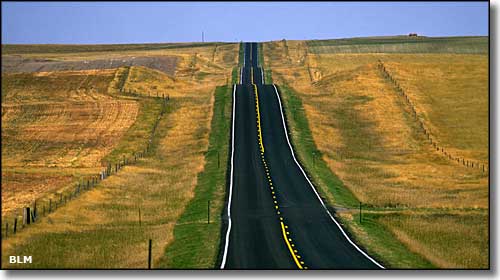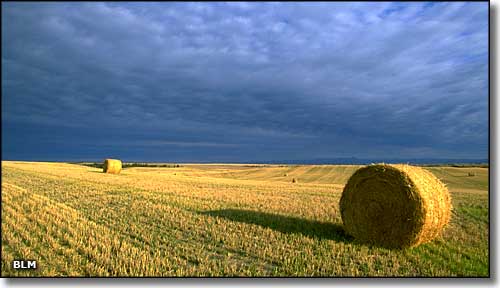 |
|---|
Agricultural Issues - Making Hay |
|
|
 |
|
There are two basic types of hay grown in the Intermountain West: alfalfa and grass hay. These can be planted individually or in alfalfa/grass mixes. Depending on weather, elevation and type of hay, pastures in this area can be harvested 1 to 5 times per year. Yields average 1.5 tons per acre on non-irrigated land and 3.6 tons per acre on irrigated land. Alfalfa is typically grown on irrigated land but also grows well where is more than 15 inches of annual rainfall and the soil is 2 feet deep. The most common method of establishing an alfalfa field is to plow and disk the field, then drill and pack the seed. An alternative is to apply a broad spectrum herbicide (such as Roundup™) and then drill the alfalfa seed into the existing dead vegetation. The alternative method is slightly cheaper and causes less soil erosion but it doesn't level or fertilize the field, both of which make harvesting easier. Alfalfa stands can last 10 years or more. Before seeding, a soil test for nitrogen and phosphorus should be done. This will help to ensure that adequate fertilizing happens. The most common reason for the failure of and alfalfa establishment is poor seed bed preparation. The seed bed needs to be firm and this is best accomplished by using a cultipacker or packer wheels on the drill when seeding. Alfalfa is usually harvested when the plants reach 1/10 bloom: mid to late May at lower elevations, mid to late June in the foothills. Irrigated fields will typically yield 2-4 tons per acre. Grass hays are usually a combination of brome grass, timothy grass, orchard grass and fescue. Grass hays normally can be harvested only once or twice per year but this can be increased by tossing alfalfa seed into the mix. Dryland grass hays in the foothills average 1-2 tons per acre while irrigation can raise this to 2-3 tons per acre. Grass hay is usually harvested from early June into August. Delaying the harvest can increase yields slightly but it also decreases the nutritional content. For best production, harvest when the plants are flowering. Usually, good quality alfalfa hay can bring $80 to $100 per ton while good quality grass hay can bring $70 to $90 per ton. Most small producers either use the hay themselves or market it to other small consumers (local horse and livestock owners). Locally, there is a strong demand for hay. Horse hay, preferably, consists of alfalfa/grass mix with a high timothy content. It also needs to be bright green (harvested early in the season and not rained on after mowing) and with no mold in the bale. Horse owners also prefer the small, square, 70 pound bales to the large, round 1200 pound bales. Usually word-of-mouth is enough to get you set up with perennial buyers. A new market being established is "certified weed free." The USFS and most DOW's allow only certified weed free hay on their properties. To get this designation requires an inspection of the field prior to mowing (to ensure there are no noxious weeds in the mix) and then labeling and marketing the bales as "certified weed free." This can add 5 to 10 percent to the market price. |
 |
|
|
 |
| Index - Arizona - Colorado - Idaho - Montana - Nevada - New Mexico - Utah - Wyoming National Forests - National Parks - Scenic Byways - Ski & Snowboard Areas - BLM Sites Wilderness Areas - National Wildlife Refuges - National Trails - Rural Life Advertise With Us - About This Site - Privacy Policy |
| Large photos courtesy of the Bureau of Land Management Text Copyright © by Sangres.com. All rights reserved. |